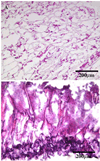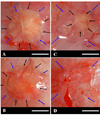Elastase-sensitive elastomeric scaffolds with variable anisotropy for soft tissue engineering
- PMID: 18509596
- PMCID: PMC2860885
- DOI: 10.1007/s11095-008-9628-x
Elastase-sensitive elastomeric scaffolds with variable anisotropy for soft tissue engineering
Abstract
Purpose: To develop elastase-sensitive polyurethane scaffolds that would be applicable to the engineering of mechanically active soft tissues.
Methods: A polyurethane containing an elastase-sensitive peptide sequence was processed into scaffolds by thermally induced phase separation. Processing conditions were manipulated to alter scaffold properties and anisotropy. The scaffold's mechanical properties, degradation, and cytocompatibility using muscle-derived stem cells were characterized. Scaffold in vivo degradation was evaluated by subcutaneous implantation.
Results: When heat transfer was multidirectional, scaffolds had randomly oriented pores. Imposition of a heat transfer gradient resulted in oriented pores. Both scaffolds were flexible and relatively strong with mechanical properties dependent upon fabrication conditions such as solvent type, polymer concentration and quenching temperature. Oriented scaffolds exhibited anisotropic mechanical properties with greater tensile strength in the orientation direction. These scaffolds also supported muscle-derived stem cell growth more effectively than random scaffolds. The scaffolds expressed over 40% weight loss after 56 days in elastase containing buffer. Elastase-sensitive scaffolds were complete degraded after 8 weeks subcutaneous implantation in rats, markedly faster than similar polyurethanes that did not contain the peptide sequence.
Conclusion: The elastase-sensitive polyurethane scaffolds showed promise for application in soft tissue engineering where controlling scaffold mechanical properties and pore architecture are desirable.
Figures










Similar articles
-
Preparation and characterization of highly porous, biodegradable polyurethane scaffolds for soft tissue applications.Biomaterials. 2005 Jun;26(18):3961-71. doi: 10.1016/j.biomaterials.2004.10.018. Biomaterials. 2005. PMID: 15626443 Free PMC article.
-
Tailoring the degradation kinetics of poly(ester carbonate urethane)urea thermoplastic elastomers for tissue engineering scaffolds.Biomaterials. 2010 May;31(15):4249-58. doi: 10.1016/j.biomaterials.2010.02.005. Epub 2010 Feb 25. Biomaterials. 2010. PMID: 20188411 Free PMC article.
-
Synthesis and characterization of biodegradable elastomeric polyurethane scaffolds fabricated by the inkjet technique.Biomaterials. 2008 Oct;29(28):3781-91. doi: 10.1016/j.biomaterials.2008.06.009. Epub 2008 Jul 3. Biomaterials. 2008. PMID: 18602156
-
Injectable biodegradable polyurethane scaffolds with release of platelet-derived growth factor for tissue repair and regeneration.Pharm Res. 2008 Oct;25(10):2387-99. doi: 10.1007/s11095-008-9618-z. Epub 2008 May 31. Pharm Res. 2008. PMID: 18516665 Free PMC article.
-
A review: fabrication of porous polyurethane scaffolds.Mater Sci Eng C Mater Biol Appl. 2015 Mar;48:586-91. doi: 10.1016/j.msec.2014.12.037. Epub 2014 Dec 17. Mater Sci Eng C Mater Biol Appl. 2015. PMID: 25579961 Review.
Cited by
-
Fabrication and evaluation of physical properties and cytotoxicity of zein-based polyurethanes.J Mater Sci Mater Med. 2014 Mar;25(3):823-33. doi: 10.1007/s10856-013-5117-9. Epub 2013 Dec 13. J Mater Sci Mater Med. 2014. PMID: 24338333
-
A small diameter, fibrous vascular conduit generated from a poly(ester urethane)urea and phospholipid polymer blend.Biomaterials. 2009 May;30(13):2457-67. doi: 10.1016/j.biomaterials.2009.01.013. Epub 2009 Feb 1. Biomaterials. 2009. PMID: 19181378 Free PMC article.
-
Synthesis and characterization of dual stimuli responsive macromers based on poly(N-isopropylacrylamide) and poly(vinylphosphonic acid).Biomacromolecules. 2010 Mar 8;11(3):797-805. doi: 10.1021/bm9014182. Biomacromolecules. 2010. PMID: 20121076 Free PMC article.
-
A bilayered elastomeric scaffold for tissue engineering of small diameter vascular grafts.Acta Biomater. 2010 Jan;6(1):110-22. doi: 10.1016/j.actbio.2009.06.026. Epub 2009 Jun 18. Acta Biomater. 2010. PMID: 19540370 Free PMC article.
-
Anisotropic Materials for Skeletal-Muscle-Tissue Engineering.Adv Mater. 2016 Dec;28(48):10588-10612. doi: 10.1002/adma.201600240. Epub 2016 Nov 16. Adv Mater. 2016. PMID: 27865007 Free PMC article. Review.
References
-
- Niklason LE, Gao J, Abbott WM, Hirschi KK, Houser S, Marini R, Langer R. Functional arteries grown in vitro. Science. 1999;284:489–493. - PubMed
-
- Hoerstrup SP, Zund G, Sodian R, Schnell AM, Grunenfelder J, Turina MI. Tissue engineering of small caliber vascular grafts. Eur. J. Cardiothorac. Surg. 2001;20:164–169. - PubMed
-
- Tiwari A, Salacinski HJ, Punshon G, Hamilton G, Seifalian AM. Development of a hybrid cardiovascular graft using a tissue engineering approach. FASEB J. 2002;16:791–796. - PubMed
-
- Opitz F, Schenke-Layland K, Richter W, Martin DP, Degenkolbe I, Wahlers T, Stock UA. Tissue engineering of ovine aortic blood vessel substitutes using applied shear stress and enzymatically derived vascular smooth muscle cells. Ann. Biomed. Eng. 2004;32:212–222. - PubMed
Publication types
MeSH terms
Substances
Grants and funding
LinkOut - more resources
Full Text Sources

